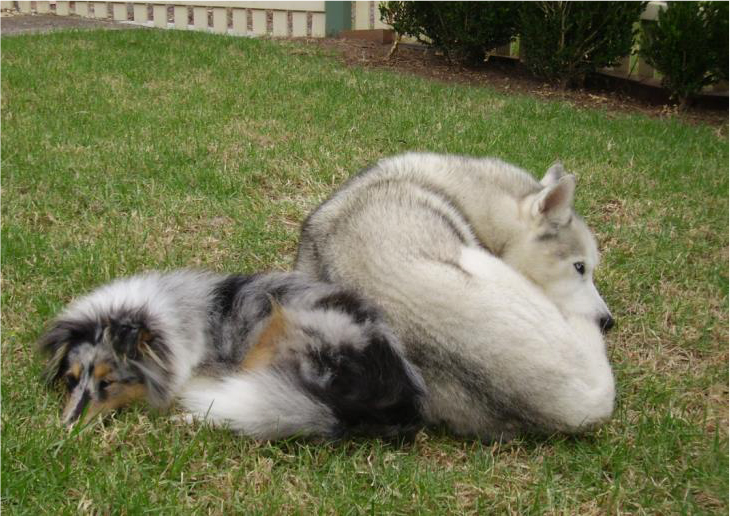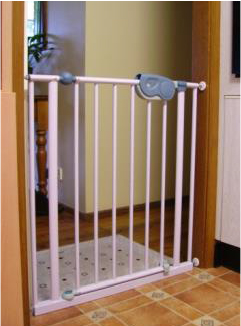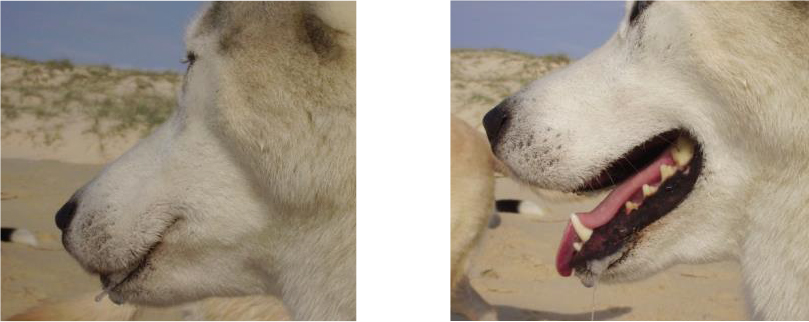The Art of Introducing Dogs (7 page)
Read The Art of Introducing Dogs Online
Authors: Louise Ginman

Sniffing is a calming behaviour. Allow the dogs to sniff trees and other interesting scents together. These dogs are off lead but sniffing together on lead is just as important.
Once side by side walking has been accomplished, the dogs that started with off lead introductions are ready to go home. Congratulations on getting this far.
The dogs that started with on lead introductions still need to complete the off lead section of the introduction if you are introducing a new member of your family, so please go back and follow those instructions before proceeding to take the dog’s home. If the purpose of your on lead introductions was solely to add a new dog into your walking group or on lead activity, then well done, you have completed your introduction.
Chapter 3
A new dog at home

Preparing to take the dogs home
Good planning is the key to successfully introducing the new dog to your home. It is strongly recommended that you are at home for the first 2-3 weeks once you bring the new dog home so that you can supervise all interactions, giving praise and feedback to the dogs as required.
Before you bring the new dog home, remove all resources if you suspect your dog may guard toys, food etc., from the new dog or puppy. In fact, even if you don’t think your dog will guard resources, the newcomer might. Plan ahead so that resources are slowly removed several weeks in advance of the new dogs’ arrival. Put toys away, get rid of those buried bones and buy an extra bed and bowls for the newcomer. Slow removal of items and changes around your home are preferred to sudden changes so that your dog does not become stressed prior to the new dogs’ arrival.
Use baby gates and crates for ‘in house’ separations. Slowly begin to set these so that all are in place 2–3 weeks prior to the new dog or puppies’ arrival so your dog has a chance to get used to the changes in the home. Decide where each dog will be fed. They will need separate feeding areas, preferably with a physical barrier between them e.g. a baby gate. Provide multiple water sources and at least two beds or resting areas per dog to prevent issues arising over resting areas. Beware that food and resting areas can be highly prized resources to some dogs so manage these areas carefully.

Adding baby gates around your home can assist to manage the dogs during feeding time as well as prevent access to specific areas of your home. Works especially well while you are toilet training a new puppy or dog, or even to save your bed linen from muddy paws.
There are three things I recommend to assist in keeping stress levels low during all phases of the introduction. Firstly, the use of calming formulas made of Bach flower or wild flower essences and homeopathic remedies supplied by qualified animal practitioners. If you don’t have an animal naturopath/practitioner close to you, then you can use Rescue Remedy instead. These natural remedies are generally added to both dogs water bowls and food several times per day if possible (follow the instructions given to you by the practitioner) for two weeks prior to attempting the at home introduction and then continue for up to 3-6 months till they are best friends. You can also take your own version to manage your own stress levels! The second recommendation is to purchase “Through a Dog’s Ear” music CDs. There are currently several versions available to suit different situations. The music is termed bio acoustic as it has been specifically developed and scientifically tested to have a calming effect on the nervous system of dogs. Play the CD at home for your dogs to encourage a sense of calm and relaxation.
Finally, purchase D.A.P spray, diffuser and collars (also known as ADAPTIL). D.A.P stands for Dog Appeasing Pheromone. This is the pheromone that a lactating bitch produces to soothe her suckling puppies. In dogs, it reduces anxiety and stress and helps the new dog or puppy to feel calmer in the new environment. IT will also help your current dog to feel calmer during the initial disruption that the new arrival brings to your home. Using all three D.A.P products will provide a calming atmosphere whether the dogs are indoors or outdoors. I recommend using these products for the first 3 months of the introduction. The diffuser can be set up in the home for a constant stream of the pheromone while the spray can be used outdoors and in the car where its effects last for approximately two hours. The collar should be worn continuously by both dogs for up to 3 months — note each collar lasts one month so should be replaced to remain effective.
If possible, do the final introduction on the day that you have decided to bring the new dog or puppy home so that both dogs can return home together either by car or walking. If coming home by car, the dogs will need to be separated. The use of crates or simply separating the dogs in a station wagon works well. Place one in the wagon and the other on the back seat, appropriately harnessed or restrained if not in crates. Ensure you have one or two people on hand at home to assist you for the first few days as management of both dogs at this time will be crucial to ensure that everything goes smoothly.
Once you arrive home, do a final check to ensure all resources have been removed. Start with the dogs in the front yard. If you have a fenced front yard even better, as the dogs can be off lead. If they have to stay on lead, walk them around and then allow periods of doing nothing in between. Keep the dogs in this area with one or more water bowls for several hours if possible, until they are relaxed, calm and resting. Drinking together from one bowl is a good sign that they are feeling relaxed with each other. Do not offer food or any other resource during these initial introductions to your home.
Once the dogs have been calm and relaxed for at least 30 minutes, proceed to take them into the backyard. This is your resident dogs primary territory so expect tension to rise temporarily again in this new area. Monitor the dogs at all times by providing 100% supervision (this is why you need two people) and continue with the happy light voices and lots of calm praise for all positive interactions, but take care to keep emotions under control. Minimise excitement as the dogs are still getting used to moving around each other and excitement can quickly lead to problems. Where possible, remove yourself from the dogs interactions i.e. watch them closely and intervene quickly if any signs of tension are seen but otherwise allow them to relax and explore without you standing over them or patting them. We can inadvertently add to a dog’s excitement or guarding tendencies by being too hands on during this important ‘getting to know you’ stage. If you have to intervene, use a happy voice to call the dogs away from each other and briefly separate using leads or baby gates. Tension in our own bodies and voices, or any form of punishment, can stress one or both dogs and adversely affect the success of the introduction. So avoid getting cranky with either one of the dogs. In training it is always best to tell the dogs what you would like them to do rather than telling them what you do not want them to do. Where tension appears to be rising, simply manage the situation by separating the dogs briefly to allow the problem to be removed, stress to be decreased or excitement to calm down.
Allow the dogs to remain in the back yard for a further few hours before moving into the house. Follow the exact same procedure as for the other areas. Ensure the DAP is plugged in and calming music is playing. Ideally, spend only short periods of time indoors initially as this area tends to be more confined and involves having to walk past each other closely through doorways or past feeding points. In order to keep things calm and peaceful with tension low, move outdoors often.
Let the dogs rest wherever and whenever they feel comfortable. Puppies will always try to rest with their new doggie friend which may or may not be welcome just yet. Calmness is good, so encourage quiet resting. Keep game playing for when they are really familiar with each other and closely bonded. Right now, and for the next week, we want them to be quiet, calm and rest. This keeps stress levels low and emotions under control.
At mealtime, separate the dogs using crates and/or baby gates. Take care during meal preparation that scraps are not dropped onto the floor causing food aggression between the dogs. Randomly mix up which dog is fed first so that they never know who will be fed first. Teach a sit-stay or ‘wait’ so that dogs can wait while you take the other to its feeding location. At the completion of a meal, remove all leftovers and bowls. Taking care with food and feeding will help to reduce tension between the dogs.

Tension in a dog’s mouth can tell you a lot about how they are feeling about something or someone. Look at the difference in this dogs’ mouth. On the left, the mouth is closed and tense. The corners of the mouth are drawn forward towards the nose. This dog appears tense. Look at the same dog on the right. The mouth is open and relaxed; the corner of the mouth is drawn back and is in line with the eye. This dog now appears more relaxed.
How quickly the dogs settle and become friends will depend on their own temperaments and personalities and how well you manage the dogs. The older your existing dog is, sometimes the longer it will take for him to feel calm and comfortable in the new dog/pups presence. A dog that has not ever had to share his home with another dog (except to have the occasional play mate over for a few hours) will likely feel stressed having another dog in the house upsetting the daily routine. Your dog may go off his food for a few days or more or just generally not be himself. Give him some time and keep up the daily routine as much as possible to help your dog to cope with the changes in your home. In general, you need to allow 4–8 weeks for the dogs to settle but it can also take up to 6–9 months for the dogs to be really well bonded and comfortable with each other. If you are unsure, or are seeing behaviours from one or both dogs that concern you, seek help immediately from a qualified dog behavioural trainer. The sooner you tackle the problem, the better it will be for all concerned. Most people wait to call a trainer until the problem has gotten to breaking point. By then it can be too late or at minimum will take a lot longer and more work to resolve. So tackle all issues quickly.
Refrain from giving toys, bones, or other resources until both are highly bonded — which if you are lucky, and your dogs are both young, may take several days to several months or more. Once you do begin to re-introduce resources, do it slowly and start with low value resources e.g. least favourite toys, low value food items etc. Monitor the dogs closely for each and every item given. Look for tension in the body and mouth from one or both dogs and intervene quickly to remove the dogs or the resource if safe to do so, to prevent tension building into a confrontation. Assist the dogs to feel comfortable with each other in close proximity by handfeeding the dogs side by side if safe to do so. Say each dog’s name before giving that dog a treat so that they learn when something is for them and when it is for the other dog. See the books listed in the resources section to learn more about living in and managing multidog households.
